Page 13 of 376
1-
yellowblue
1-1
Section 1 Seats and Restraint Systems
Here you'll find information about the seats in your vehicle and how to use your safety belts properly. You can also
learn about some things you should not do with air bags and safety belts.
1
-2 Seats and Seat Controls
1
-7 Safety Belts: They're for Everyone
1
-11 Here Are Questions Many People Ask About
Safety Belts
-- and the Answers
1
-12 How to Wear Safety Belts Properly
1
-12 Driver Position
1
-19 Safety Belt Use During Pregnancy
1
-20 Passenger Position1
-20 Air Bag System
1
-26 Children
1
-27 Child Restraints
1
-36 Larger Children
1
-39 Safety Belt Extender
1
-39 Checking Your Restraint Systems
1
-40 Replacing Restraint System Parts
After a Crash
Page 24 of 376
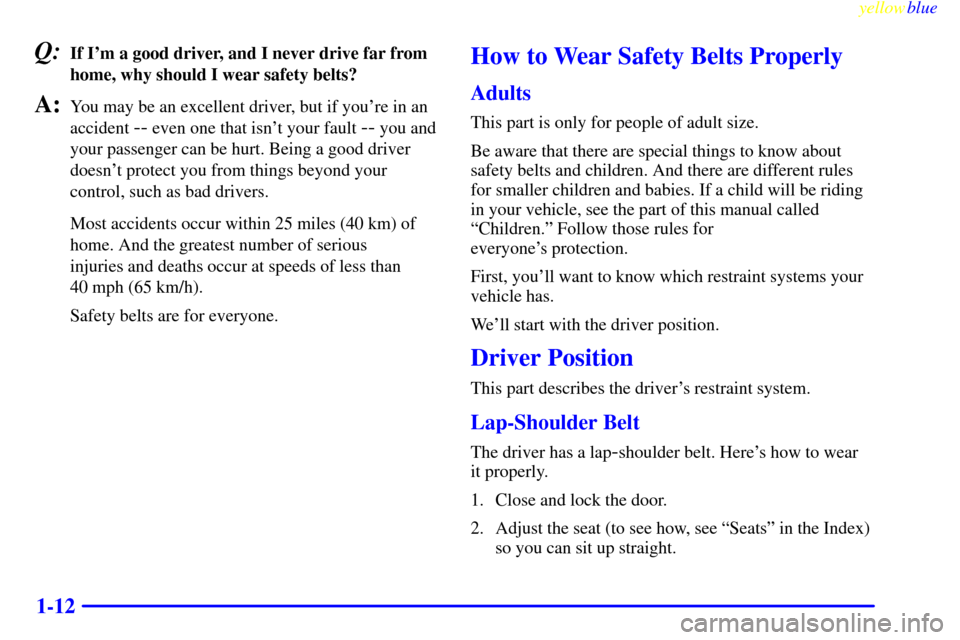
yellowblue
1-12
Q:If I'm a good driver, and I never drive far from
home, why should I wear safety belts?
A:You may be an excellent driver, but if you're in an
accident
-- even one that isn't your fault -- you and
your passenger can be hurt. Being a good driver
doesn't protect you from things beyond your
control, such as bad drivers.
Most accidents occur within 25 miles (40 km) of
home. And the greatest number of serious
injuries and deaths occur at speeds of less than
40 mph (65 km/h).
Safety belts are for everyone.
How to Wear Safety Belts Properly
Adults
This part is only for people of adult size.
Be aware that there are special things to know about
safety belts and children. And there are different rules
for smaller children and babies. If a child will be riding
in your vehicle, see the part of this manual called
ªChildren.º Follow those rules for
everyone's protection.
First, you'll want to know which restraint systems your
vehicle has.
We'll start with the driver position.
Driver Position
This part describes the driver's restraint system.
Lap-Shoulder Belt
The driver has a lap-shoulder belt. Here's how to wear
it properly.
1. Close and lock the door.
2. Adjust the seat (to see how, see ªSeatsº in the Index)
so you can sit up straight.
Page 33 of 376
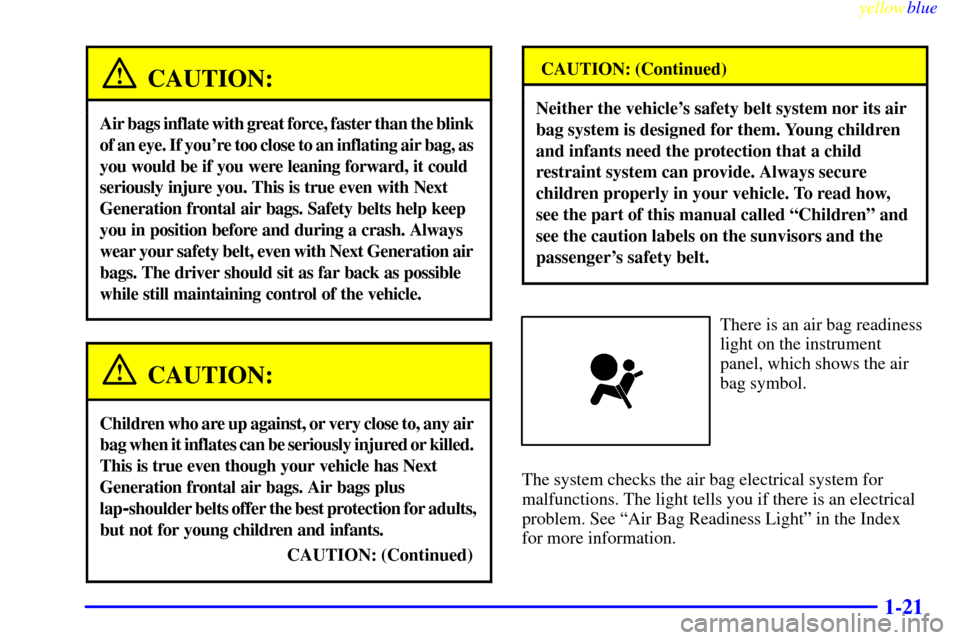
yellowblue
1-21
CAUTION:
Air bags inflate with great force, faster than the blink
of an eye. If you're too close to an inflating air bag, as
you would be if you were leaning forward, it could
seriously injure you. This is true even with Next
Generation frontal air bags. Safety belts help keep
you in position before and during a crash. Always
wear your safety belt, even with Next Generation air
bags. The driver should sit as far back as possible
while still maintaining control of the vehicle.
CAUTION:
Children who are up against, or very close to, any air
bag when it inflates can be seriously injured or killed.
This is true even though your vehicle has Next
Generation frontal air bags. Air bags plus
lap
-shoulder belts offer the best protection for adults,
but not for young children and infants.
CAUTION: (Continued)
CAUTION: (Continued)
Neither the vehicle's safety belt system nor its air
bag system is designed for them. Young children
and infants need the protection that a child
restraint system can provide. Always secure
children properly in your vehicle. To read how,
see the part of this manual called ªChildrenº and
see the caution labels on the sunvisors and the
passenger's safety belt.
There is an air bag readiness
light on the instrument
panel, which shows the air
bag symbol.
The system checks the air bag electrical system for
malfunctions. The light tells you if there is an electrical
problem. See ªAir Bag Readiness Lightº in the Index
for more information.
Page 38 of 376
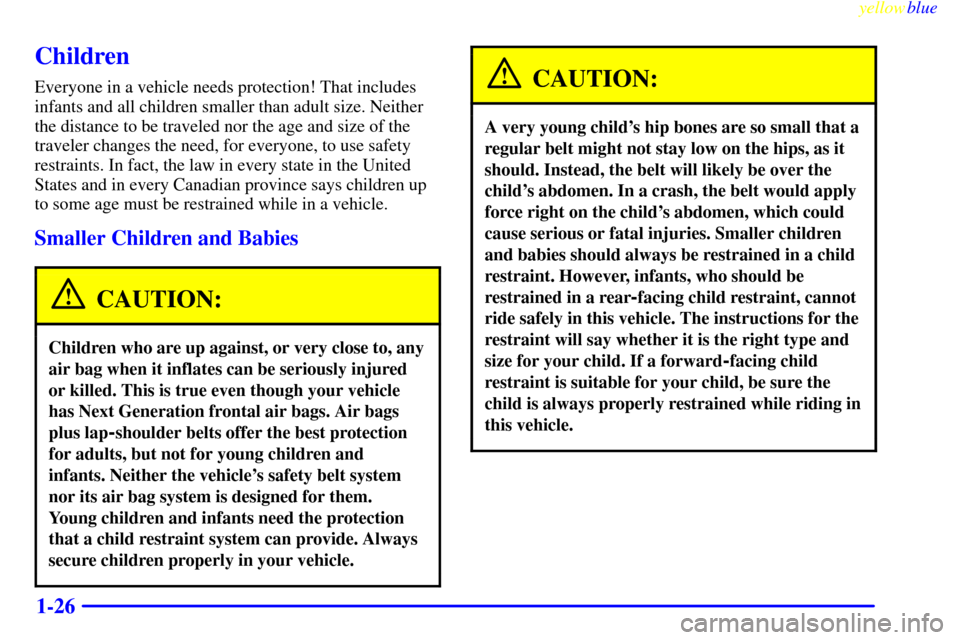
yellowblue
1-26
Children
Everyone in a vehicle needs protection! That includes
infants and all children smaller than adult size. Neither
the distance to be traveled nor the age and size of the
traveler changes the need, for everyone, to use safety
restraints. In fact, the law in every state in the United
States and in every Canadian province says children up
to some age must be restrained while in a vehicle.
Smaller Children and Babies
CAUTION:
Children who are up against, or very close to, any
air bag when it inflates can be seriously injured
or killed. This is true even though your vehicle
has Next Generation frontal air bags. Air bags
plus lap
-shoulder belts offer the best protection
for adults, but not for young children and
infants. Neither the vehicle's safety belt system
nor its air bag system is designed for them.
Young children and infants need the protection
that a child restraint system can provide. Always
secure children properly in your vehicle.
CAUTION:
A very young child's hip bones are so small that a
regular belt might not stay low on the hips, as it
should. Instead, the belt will likely be over the
child's abdomen. In a crash, the belt would apply
force right on the child's abdomen, which could
cause serious or fatal injuries. Smaller children
and babies should always be restrained in a child
restraint. However, infants, who should be
restrained in a rear
-facing child restraint, cannot
ride safely in this vehicle. The instructions for the
restraint will say whether it is the right type and
size for your child. If a forward
-facing child
restraint is suitable for your child, be sure the
child is always properly restrained while riding in
this vehicle.
Page 39 of 376
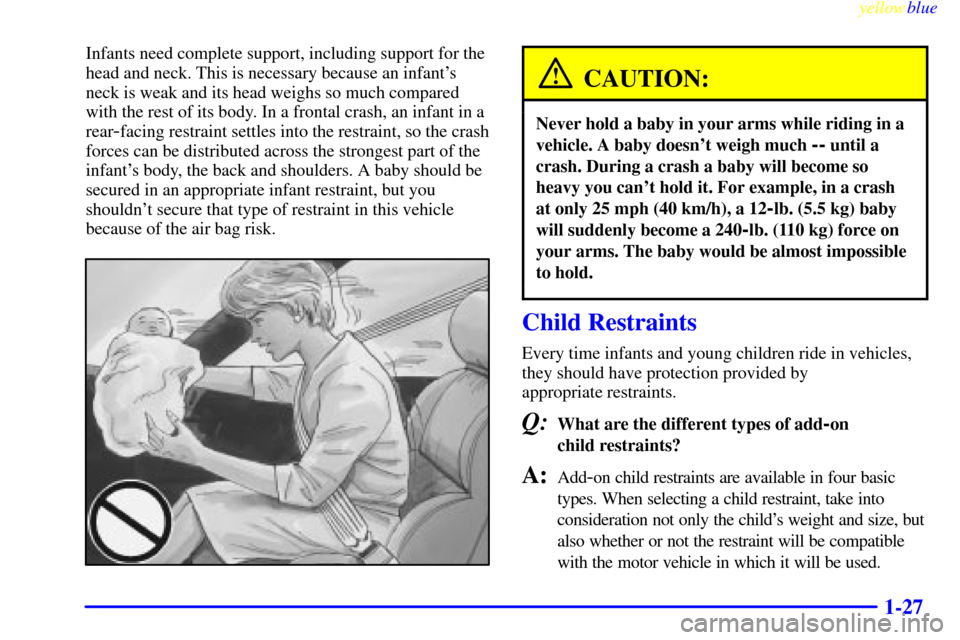
yellowblue
1-27
Infants need complete support, including support for the
head and neck. This is necessary because an infant's
neck is weak and its head weighs so much compared
with the rest of its body. In a frontal crash, an infant in a
rear
-facing restraint settles into the restraint, so the crash
forces can be distributed across the strongest part of the
infant's body, the back and shoulders. A baby should be
secured in an appropriate infant restraint, but you
shouldn't secure that type of restraint in this vehicle
because of the air bag risk.
CAUTION:
Never hold a baby in your arms while riding in a
vehicle. A baby doesn't weigh much
-- until a
crash. During a crash a baby will become so
heavy you can't hold it. For example, in a crash
at only 25 mph (40 km/h), a 12
-lb. (5.5 kg) baby
will suddenly become a 240
-lb. (110 kg) force on
your arms. The baby would be almost impossible
to hold.
Child Restraints
Every time infants and young children ride in vehicles,
they should have protection provided by
appropriate restraints.
Q:What are the different types of add-on
child restraints?
A:Add-on child restraints are available in four basic
types. When selecting a child restraint, take into
consideration not only the child's weight and size, but
also whether or not the restraint will be compatible
with the motor vehicle in which it will be used.
Page 40 of 376
yellowblue
1-28
An infant car bed (A) is a special bed made for use
in a motor vehicle. It's an infant restraint system
designed to restrain or position a child on a
continuous flat surface. With an infant car bed,
make sure that the infant's head rests toward the
center of the vehicle.A rear-facing infant restraint (B) positions an infant
to face the rear of the vehicle. Rear
-facing infant
restraints are designed for infants of up to about
20 lbs. (9 kg) and about one year of age. This type
of restraint faces the rear so that the infant's head,
neck and body can have the support they need in a
frontal crash. Some infant seats come in two
parts
-- the base stays secured in the vehicle and
the seat part is removable.
Page 42 of 376
yellowblue
1-30
A forward-facing child restraint (C-E) positions a
child upright to face forward in the vehicle. These
forward
-facing restraints are designed to help
protect children who are from 20 to 40 lbs. (9 to
18 kg) and about 26 to 40 inches (66 to 102 cm) in
height, or up to around four years of age. One type,
a convertible restraint, is designed to be used either
as a rear
-facing infant seat or a forward-facing
child seat.
Page 43 of 376
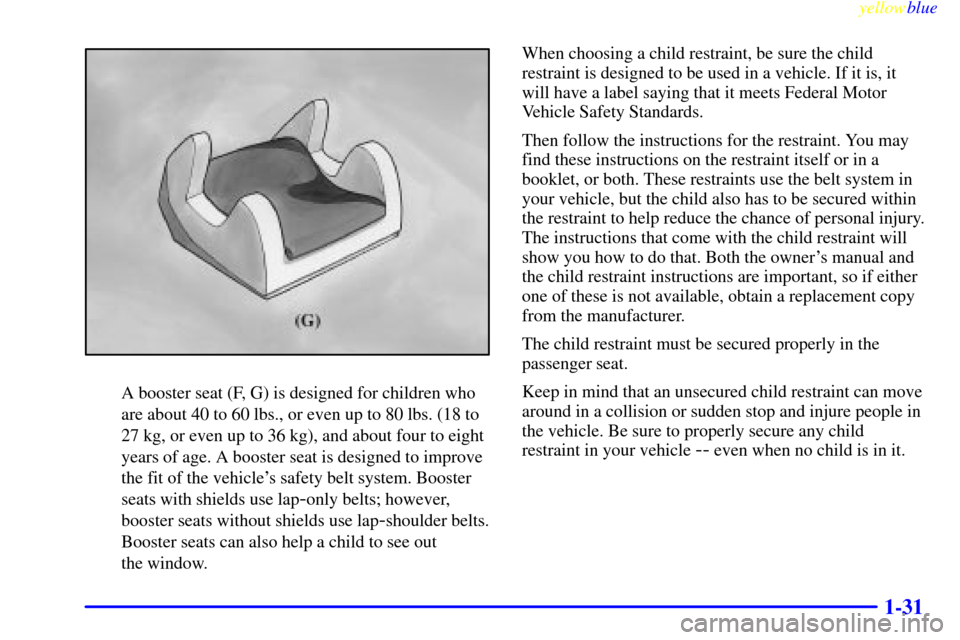
yellowblue
1-31
A booster seat (F, G) is designed for children who
are about 40 to 60 lbs., or even up to 80 lbs. (18 to
27 kg, or even up to 36 kg), and about four to eight
years of age. A booster seat is designed to improve
the fit of the vehicle's safety belt system. Booster
seats with shields use lap
-only belts; however,
booster seats without shields use lap
-shoulder belts.
Booster seats can also help a child to see out
the window.When choosing a child restraint, be sure the child
restraint is designed to be used in a vehicle. If it is, it
will have a label saying that it meets Federal Motor
Vehicle Safety Standards.
Then follow the instructions for the restraint. You may
find these instructions on the restraint itself or in a
booklet, or both. These restraints use the belt system in
your vehicle, but the child also has to be secured within
the restraint to help reduce the chance of personal injury.
The instructions that come with the child restraint will
show you how to do that. Both the owner's manual and
the child restraint instructions are important, so if either
one of these is not available, obtain a replacement copy
from the manufacturer.
The child restraint must be secured properly in the
passenger seat.
Keep in mind that an unsecured child restraint can move
around in a collision or sudden stop and injure people in
the vehicle. Be sure to properly secure any child
restraint in your vehicle
-- even when no child is in it.